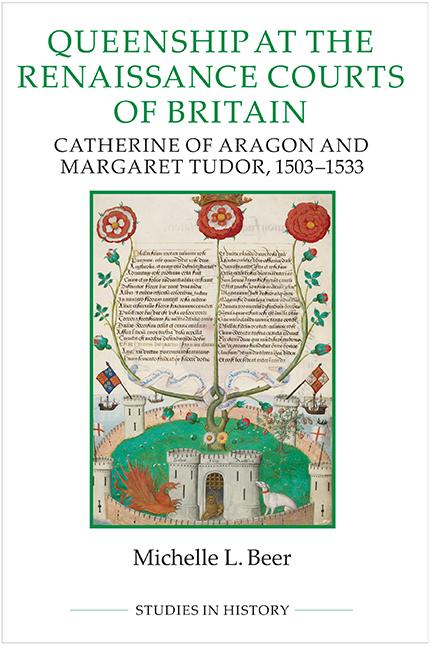Book contents
2 - Material magnificence, royal identity and the queen's body
Published online by Cambridge University Press: 24 October 2019
Summary
‘[the Queen] was very richly attired, and had with her 25 damsels mounted on white palfreys, with housings all of one fashion, most beautifully embroidered with gold; and all these damsels wore dresses slashed with gold lama in very costly trim, and were attended by a number of footmen in excellent order’.
‘After the joust the ambassadors visited the Queen … She is rather ugly than otherwise, and supposed to be pregnant; but the damsels of her court are handsome, and make a sumptuous appearance.’
These two assessments of Catherine of Aragon, made by Nicolo Sagudino, secretary to the Venetian ambassador at the English court, emphasise the importance of clothing to the assertion of magnificence and royal identity. In his description of Catherine's appearance at a major court ceremony, Sagudino does not focus solely on the queen's physical looks; instead, he links together the queen's own presence with her clothing and the clothing of her attendants. Although Catherine herself is ‘rather ugly than otherwise’, the ladies of her court and her own rich attire supersede her physical form. Her body, which was ‘supposed’ to be pregnant, was one part of her presence as queen, but it was figuratively and literally obscured by the ‘rich attire’ of her own clothing and the dresses of her ladies. Sagudino's focus on Catherine's attire, and the attire of her ladies, is not unusual; nearly every detailed description of Catherine discusses her personal appearance and the fabric, cut or style of her clothing, and many sources include descriptions of her ladies. Ambassadors like Sagudino focused on the queen's appearance because Renaissance monarchs used sumptuous, rare clothing to reinforce their status and authority, as the idea of magnificence became a crucial political and social concept and humanist virtue for kings and queens. Catherine's identity as queen was thus formed not only through her actions, but through her appearance, dress and company as well.
Catherine and Margaret used clothing to emphasise their agency and superior social status compared to the men around them in order to maintain royal dignity and their own authority, which was especially crucial at moments when they faced challenges at court. Because their marriages placed them above all other men in their kingdoms, save their husbands, their identities, honour and status as queens had to be asserted and re-asserted.
- Type
- Chapter
- Information
- Queenship at the Renaissance Courts of BritainCatherine of Aragon and Margaret Tudor 1503–1533, pp. 45 - 69Publisher: Boydell & BrewerPrint publication year: 2018



